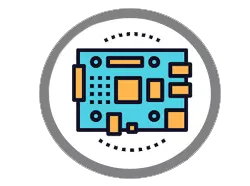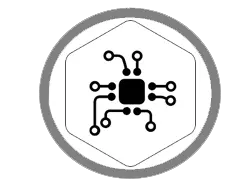RF Microwave Wireless Product Design
RF System Design and RF PCB design is considered to be a niche domain requiring exceptional understanding of constrained, exhaustive guidelines and general pitfalls. Selection and placement of components even if material for RF PCB Manufacturing is not chosen wisely could cause complete failure of the RF System design, which could have been done with utmost care at the design phase. We will delve further on RF PCB Design and try to understand why it is highly recommended to give your RF PCB design and PCB layout Design projects to only specialized firm.
RF (Radio Frequency) is a part of electromagnetic spectrum having frequencies from 3 kHz to 300GHz with wavelengths ranging from 1 mm to 100 KM, travelling at the speed of light. A part of Radio frequency spectrum between 300MHz to 300GHz is known as Microwave which includes UHF, EHF and SHF band. RF signals can be characterized as high frequency analogue signals. As the signals are analogue in nature and mostly travel over-the-air the amplitude,voltage and current levels are not defined but vary as per environment and medium. To add to the complexity of the analogue signal, its not single frequency but generally band of frequencies so the RF and Microwave PCB design and RF circuits are designed to pass the desired band and filter out the rest.

RF Systems
- 6.4 GHZ - Wireless Radio
- 8-12GHz X band Receiver
- 400 MHz Synthesizer
- LTE Remote Radio Head
- 2.4GHz : RFID
- 900MHz : RFID
- 2.4GHz : Bluetooth, BLE
- 2.4GHz : Zigbee
- 2.4/5.2GHz :WiFi
- 868/915MHz :LoRa, LoRaWAN
- 868 MHz : Sigfox
- 900 MHz – FHSS
- 4G/LTE Devices
- 2G/3G Devices
- 840-960MHz UHF transceiver
- 950MHz UHF transceiver
- 433MHz UHF transceiver
- 13.56MHz HF transceiver
- 125KHz LF transceiver

RF Circuit Design
- Power Amplifier
- Power splitter
- Directional Coupler
- Attenuator
- Filters
- Antenna
- N stage Power Divider
- N Port Modulators
- Frequency Synthesizer
- Down Converter
- RFID
- Bluetooth, BLE
- zigbee, Xbee
- WiFi
- Sigfox
- LoRa, LoRaWAN
- 2G/3G GSM, CDMA
- 4G,5G
- LTE
- FHSS
- LF, HF, UHF

RF PCB Design
- Microwave and RF pcb design and are highly sensitive to noise.
- Matching Impedance is challenging as higher the frequency the lower the tolerance.
- RF design Expects Zero Return loss.
- Cross talk is directly proportional to the edge rates of the active line.
- Dissipation factor and dielectric constant value can cause huge losses.
- Taking account of Skin Depth loss: At higher frequencies electrons flow on the outer surfaces of the conductor knows as skin effect and causes the effective resistance of the conductor to increase.
- Any one of the above issue is sufficient to cause failure in the product and should be handled properly in the design phase itself.
- These issues often creep in with slight modification of placement and layout of components, vias and planes if not planned properly in advance or even while incorporating the feedbacks.
- The team which in highly experienced in RF and Microwave PCB design and follows standard processes can only suggest and overcome the challenges faced by RF and Microwave circuits.
- Use of a solid ground plane is recommended as it minimizes inductance but at the same time if not used wisely can cause capacitance problems to sensitive nodes of the circuit.
- Place RF signal lines at distances to avoid cross-talk.
- The length of the via including their inductance and capacitance value have a greater affect on very high frequency so its use with signal traces should be minimized and if possible can be avoided altogether.
- Short winding traces should follow “two points-straight line-shortest distance” method while reducing the current loop area where the receiver part is placed as close as possible to the input. This helps in reducing delay time as well as noise on the path of the PCB and improved EMI.
- Differential Traces should be placed and routed together around obstacles and should be of the same length to keep equal delays.

RF PCB Layout Design
- Use a multilayer PCB, if possible.
- Make sure return current paths are not routed under any of the sensitive Microwave and RF pcb Design circuit blocks.
- As far as possible have common low-impedance ground plane.
- Use of a solid ground plane is recommended as it minimizes inductance but at the same time if not used wisely can cause capacitance problems to sensitive nodes of the circuit.
- Place RF signal lines at distances to avoid cross-talk.
- The length of the via including their inductance and capacitance value have a greater affect on very high frequency so its use with signal traces should be minimized and if possible can be avoided altogether.
- Short winding traces should follow “two points-straight line-shortest distance” method while reducing the current loop area where the receiver part is placed as close as possible to the input. This helps in reducing delay time as well as noise on the path of the PCB and improved EMI.
- Differential Traces should be placed and routed together around obstacles and should be of the same length to keep equal delays.
- It’s good to use multiple ground vias around the signal via to maintain the characteristic impedance of via. If possible use 4-ground vias next to the signal via.
- Use best quality high frequency ceramic bypass capacitor with COG grades, if possible.
- Place capacitors as close as possible to the IC power input pins.
- Try to have multiple vias for both power supply voltage connection and Ground connection and if the vias can run into the capacitor and then into the IC it’s even better as these forces the current flow into the capacitor.
- Avoid guard rings for low leakage systems.
- Use low value resistors as anything above several Kilo ohms can cause stability issues.
- SMD packages should be preferred over through-Hole packages.
- Copper shapes and planes on the PCB can be utilized for thermal management.

RF design simulation, RF design analysis
- RF design Simulation and RF design analysis Process considers below aspects of PCB Design :
- Material Selection, Control of Impedance, Trace Design, Earth Plane, Ground Plane, Shielding, Via Management, Component Placement, and Power Supply Decoupling.
- RF Circuit Simulation and RF design analysis.
- Electronic (EM) Simulation.
- RF System Simulation.
- RF Antenna optimisation.
- RF system Thermal Simulation.
- RF system mechanical Simulation.